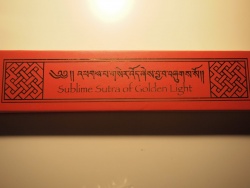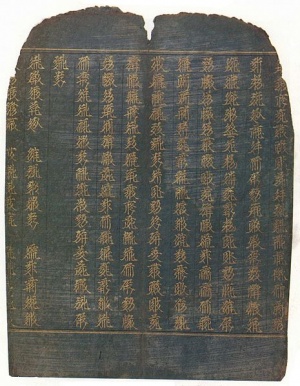Golden Light Sutra
The Suvarṇaprabhāsa-sūtra (Sanskrit: सुवर्णप्रभासोत्तमसूत्रेन्द्रराज: ; IAST: suvarṇaprabhāsottamasūtrendrarājaḥ), also known as the Altun Yaruq (Old Uyghur: altun yaruq) is a Buddhist text of the Mahayana branch of Buddhism. The title can be translated as the Sutra of Golden Light, the Golden Light Sutra or the Sutra of the Sublime Golden Light. In Tibetan, the full title is The Sovereign King of Sutras, the Sublime Golden Light.
History
The sutra was originally written in India in Sanskrit and was translated several times into Chinese by Dharmakṣema and others, and later translated into Tibetan and other languages. The sutra is an extremely important Mahayana sutra, and one of the most popular Mahayana sutras of all time. It has been translated into Khotanese, Old Turkic, Tangut, Tibetan, Mongolian, Manchu, Korean, and Japanese. The name of the sutra derives from the chapter called 'The Confession of the Golden Drum', where the bodhisattva Ruchiraketu dreams of a great drum that radiates a sublime golden light, symbolizing the Dharma, or teachings of the Buddha.[1]
It became one of the most important sutras in Japan because of its fundamental message, which teaches that the Four Guardian Gods (Chinese: 四大天王; pinyin: sì dà tiān wáng) protect the ruler who governs his country in the proper manner.[2] The sutra also expounds the vows of the Hindu goddesses Sarasvati (Chinese: 大辨才天; pinyin: dà biàn cái tiān), Lakshmi (Shri) (Chinese: 大功德天; pinyin: dà gōng dé tiān) and Drdha, the Earth Goddess, to protect any bhikshu, or monk, who will uphold and teach the sutra.[3]
Taken at face value one might take the main theme of the sutra literally, which is the importance for leaders to be good examples for the kingdom. In Chapter Twelve, the sutra speaks in verse form about the disasters that befall a kingdom when its ruler does not uphold justice, and the benefits of kings who lead an exemplary life. In the Chapter on the Guardian Kings, the Four Guardian Kings have a dialogue with the Buddha, explaining in vivid detail all the benefits a kingdom will have if its ruler enshrines the essence of the sutra and offers daily praise. The sutra contains some elements of early tantra, in that in chapter two, the sutra describes four Buddhas who dwell in the four cardinal directions. These same four comprise later Buddhist mandalas in the same positions, such as the Matrix Mandala.
Hence, historically the sutra won great esteem as a sutra for protecting the country, and often was read publicly to ward off threats. Its first reading as a court ceremony was around 660 AD, when the Tang Dynasty of China and Silla of Korea had defeated Baekche of Korea and were threatening Japan.
In 741 Emperor Shōmu (聖武天皇) founded provincial monasteries (国分寺) and nunneries (国分尼寺) in each province. The official name of the monasteries was the Temple for Protection of the State by the Four Heavenly Kings Golden Light Sutra (金光明經四天王護国之寺). The 20 monks who lived there recited the Sovereign Kings Golden Light Sutra on a fixed schedule to protect the country. As Buddhism evolved in Japan, the practice gradually fell out of use, and is no longer continued today.
Translations and publications
Some translations into Western languages exist from Sanskrit[1] and Tibetan, but there are no known translations from other languages such as Chinese, Japanese, Korean, or Mongolian.
In 1970, Prof. Emmerick produced an English translation of the short, condensed Sanskrit version of the Sutra of Golden Light into English.[4]
In Tibetan, there are three versions of the Sutra: the 21, 29, and 31 chapter versions. The 29 Chapter Version was probably the most popular in Tibet and Tibetan Buddhist regions.
In 2007, the Foundation for the Preservation of the Mahayana Tradition, Lama Zopa Rinpoche's Buddhist organization, produced a translation of the 21 chapter version of the Sutra, the most abbreviated and condensed version.[5]
The 29 and 31 Chapter Versions are currently being translated from Tibetan into English by Erick Tsiknopoulos and the Sugatagarbha Translation Group.[6]
Footnotes
- ↑ 1.0 1.1 Yiengpruksawan, Mimi Hall (1999). Hiraizumi: Buddhist Art and Regional Politics in Twelfth-Century Japan. Harvard University Asia Center. p. 167. ISBN 9780674392052.
- ↑ Brown, Delmer (1993). The Cambridge History of Japan, Vol. 1: Ancient Japan. Cambridge University Press. p. 393. ISBN 978-0521223522.
- ↑ Gregory, Peter N.; Getz Jr., Daniel A. (2002). Buddhism in the Sung. University of Hawaii Press. p. 374. ISBN 9780824826819.
- ↑ Emmerick, R. E. The Sūtra of Golden Light: Being a Translation of the Suvarṇabhāsottamasūtra. London, Luzac and Company Ltd., 1970
- ↑ "Download the Golden Light Sutra". Foundation for the Preservation of the Mahayana Tradition. Retrieved May 13, 2013.
- ↑ "The Complete Sutra of Golden Light". The Sugatagarbha Translation Group. Retrieved May 13, 2013.
Primary resources
- Sanskrit text: Bagchi, S ed. Suvarṇaprabhāsasūtram. Darbhanga: The Mithila Institute, 1967. Digital Sanskrit Buddhist Canon. (NB: in Unicode)
External links
- The Sutra of Golden Light: The 21 Chapter Version, published by the FPMT
- Tyomkin E. Unique Sanskrit Fragments of the “Sutra of Golden Light” in the manuscript collection of St Petersburg Branch of the Institute of Oriental Studies, Russian Academy of Sciences // Manuscripta Orientalia. Vol. 1, No 1, July 1995. Pp. 29-38.

